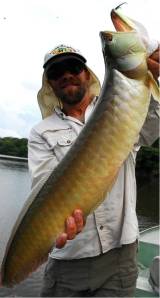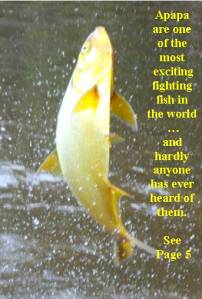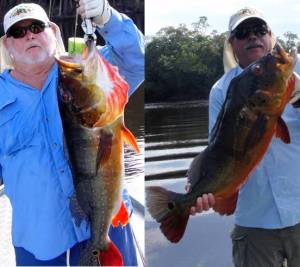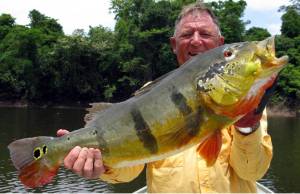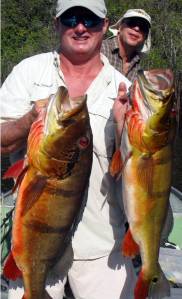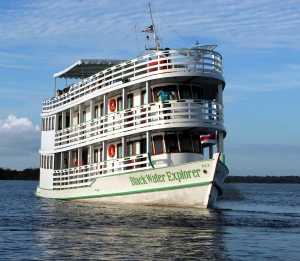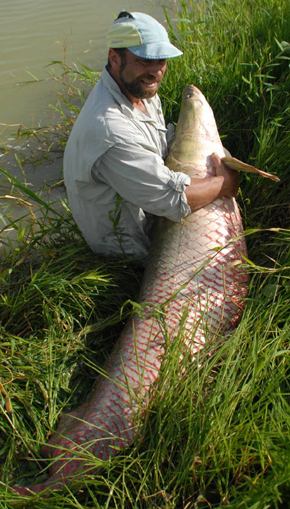 Our “Fish of the Week” is Arapaima – Pirarucu. They are the largest scaled freshwater fish in the world. Arapaima over 600 pounds and over 12 feet long were said to be not uncommon in the past, before they became a favorite of urban fish gourmets. Now a mainstay of pisciculturists, wild populations are recovering in several protected areas. Arapaima are obligatory air-breathers, periodically surfacing to gulp air. Oxygen is absorbed by a vascularized air bladder while CO2 is exchanged via their gills. Their mouth-brooding, fry-protective behavior has allowed them to succeed as transplants outside of the Amazon.
Our “Fish of the Week” is Arapaima – Pirarucu. They are the largest scaled freshwater fish in the world. Arapaima over 600 pounds and over 12 feet long were said to be not uncommon in the past, before they became a favorite of urban fish gourmets. Now a mainstay of pisciculturists, wild populations are recovering in several protected areas. Arapaima are obligatory air-breathers, periodically surfacing to gulp air. Oxygen is absorbed by a vascularized air bladder while CO2 is exchanged via their gills. Their mouth-brooding, fry-protective behavior has allowed them to succeed as transplants outside of the Amazon.
The arapaima’s enormous size, flattened head, terminal mouth and large silvery scales with bright red patterning are distinctive.
The extremely large scales are edged in bright red pigmentation forming an array of fine, diagonal, stripe-like markings. Light silvery white anterior, darkening to a steel grey, highlighted by bright red to purple markings posteriorly. They can grow up to 650 pounds (4 meters). The arapaima is truly one of a kind and not likely to be mistaken for anything else in the Amazon.
Arapaima are difficult to catch with artificial lures. Most non-targeted encounters are by peacock bass anglers who see the big beasts surfacing in a lagoon. What generally occurs immediately afterward is that two anglers will quickly whip the water into a froth, hoping to entice a hook-up. Although arapaima will occasionally strike a lure, most often the sighting leads to nothing more than an exciting interlude.
Anglers can be more successful when targeting arapaima with cut bait, or even better, live bait. Small whole fishes on a wide gap circle hook work well, especially if a small piece of foam is inserted in the gills to keep the bait near the surface. The take is very visible. Anglers should allow the line to go tight and then point the rod tip at the fish, so the circle hook can do its work. A “J” or treble hook is usually more difficult because the angler must drive the hookset into the arapaima’s bony, hard mouth. The fish at left, weighing approximately 180 pounds, was caught using a live “tamatoa” (a small armored catfish) as bait.
Once hooked, they tend to make runs appropriate to the location. In small lagoons, they tend to run to a bank or up to a heavy structure object and simply stop, perhaps they’re not yet really sure they have a problem. Once the pressure returns, they’ll leave that spot and run to another. The resulting fight consists of a series of short, albeit unstoppable runs, continuing until the fish tires. In more open water, a large fish is capable of rapidly spooling an angler. Once a run begins here, guides must quickly fire up the boat and follow or watch the line disappear into the sunset. These more sustained runs will help to tire the fish more quickly. Once the fish is at the boat (or perhaps better stated as the boat is at the fish), the real fun begins. Just because they’ve stopped running, doesn’t mean they’ll let you manhandle them into the boat for a photo. Even when tired, a fish this large and this strong can be unpredictable. It’s probably easiest to simply join the tired fish in the water for a photo (as was done at left) making for a less stressful capture (and release) for all concerned.
Acute Angling – Official Website
Facebook
Twitter
LinkedIn
YouTube
Photos


